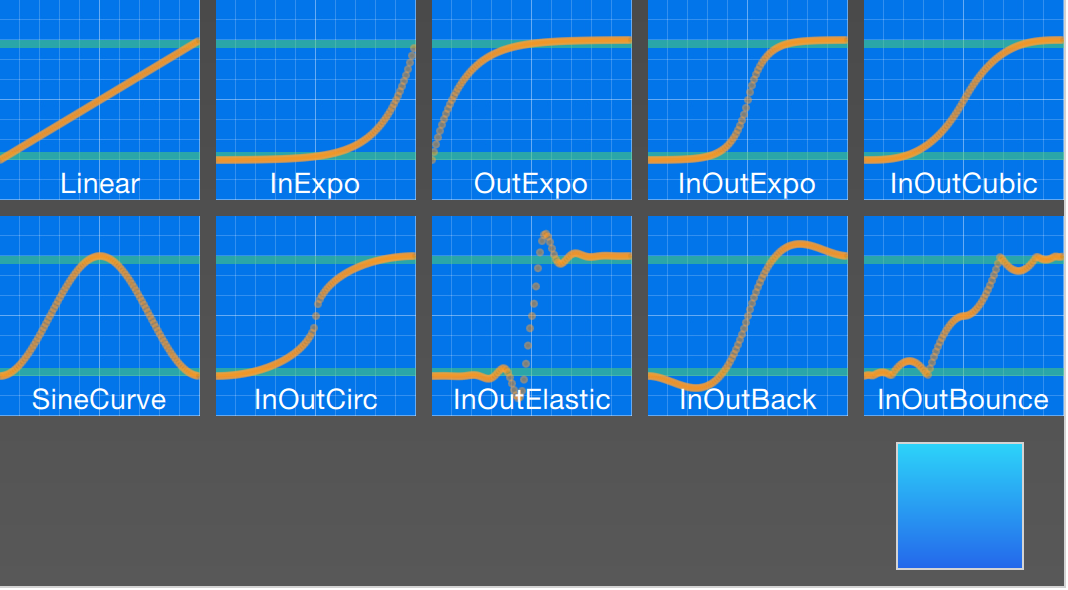5. Fluid Elements¶
Section author: jryannel@LinkedIn
Note
Last Build: December 07, 2020 at 10:50 CET
The source code for this chapter can be found in the assets folder.
Till now, we have mostly looked at simple graphical elements and how to arrange and manipulate them. This chapter is about how to control these changes in a way that a value of a property not just changes instantly, it’s more how the value changes over time: an animation. This technology is one of the key foundations for modern slick user interfaces and can be extended with a system to describe your user interface using states and transitions. Each state defines a set of property changes and can be combined with animations on state changes, called transitions.
5.1. Animations¶
Animations are applied to property changes. An animation defines the interpolation curve when for property value changes to create smooth transitions from one value to another. An animation is defined by a series of target properties to be animated, an easing curve for the interpolation curve and in the most cases a duration, which defines the time for the property change. All animations in Qt Quick are controlled by the same timer and are therefore synchronized. This improves the performance and visual quality of animations.
Note
Animations control how property changes, i.e. value interpolation. This is a fundamental concept. QML is based on elements, properties, and scripting. Every element provides dozens of properties, each property is waiting to get animated by you. In the book, you will see this is a spectacular playing field. You will catch yourself at looking at some animations and just admire their beauty and for sure also your creative genius. Please remember then: Animations control property changes and every element has dozens of properties at your disposal.
Unlock the power!

// animation.qml
import QtQuick 2.5
Image {
id: root
source: "assets/background.png"
property int padding: 40
property int duration: 4000
property bool running: false
Image {
id: box
x: root.padding;
y: (root.height-height)/2
source: "assets/box_green.png"
NumberAnimation on x {
to: root.width - box.width - root.padding
duration: root.duration
running: root.running
}
RotationAnimation on rotation {
to: 360
duration: root.duration
running: root.running
}
}
MouseArea {
anchors.fill: parent
onClicked: root.running = true
}
}
The example above shows a simple animation applied on the x and rotation property. Each animation has a duration of 4000 milliseconds (msec) and loops forever. The animation on x moves the x coordinate from the object gradually over to 240px. The animation on rotation runs from the current angle to 360 degrees. Both animations run in parallel and are started as soon as the UI is loaded.
Now you can play around with the animation by changing the to and duration property or you could add another animation for example on the opacity or even the scale. Combining these it could look like the object is disappearing into the deep space. Try it out!
5.1.1. Animation Elements¶
There are several types of animation elements, each optimized for a specific use case. Here is a list of the most prominent animations:
PropertyAnimation- Animates changes in property valuesNumberAnimation- Animates changes in qreal-type valuesColorAnimation- Animates changes in color valuesRotationAnimation- Animates changes in rotation values
Besides these basic and widely used animation elements, Qt Quick provides also more specialized animations for specific use cases:
PauseAnimation- Provides a pause for an animationSequentialAnimation- Allows animations to be run sequentiallyParallelAnimation- Allows animations to be run in parallelAnchorAnimation- Animates changes in anchor valuesParentAnimation- Animates changes in parent valuesSmoothedAnimation- Allows a property to smoothly track a valueSpringAnimation- Allows a property to track a value in a spring-like motionPathAnimation- Animates an item alongside a pathVector3dAnimation- Animates changes in QVector3d values
We will learn later how to create a sequence of animations. While working on more complex animations there comes up the need to change a property or to run a script during an ongoing animation. For this Qt Quick offers the action elements, which can be used everywhere where the other animation elements can be used:
PropertyAction- Specifies immediate property changes during animationScriptAction- Defines scripts to be run during an animation
The major animation types will be discussed in this chapter using small focused examples.
5.1.2. Applying Animations¶
Animation can be applied in several ways:
- Animation on property - runs automatically after the element is fully loaded
- Behavior on property - runs automatically when the property value changes
- Standalone Animation - runs when the animation is explicitly started using
start()orrunningis set to true (e.g. by a property binding)
Later we see also how animations can be used inside state transitions.
Extended ClickableImage Version 2
To demonstrate the usage of animations we reuse our ClickableImage component from an earlier chapter and extended it with a text element.
// ClickableImageV2.qml
// Simple image which can be clicked
import QtQuick 2.5
Item {
id: root
width: container.childrenRect.width
height: container.childrenRect.height
property alias text: label.text
property alias source: image.source
signal clicked
Column {
id: container
Image {
id: image
}
Text {
id: label
width: image.width
horizontalAlignment: Text.AlignHCenter
wrapMode: Text.WordWrap
color: "#ececec"
}
}
MouseArea {
anchors.fill: parent
onClicked: root.clicked()
}
}
To organize the element below the image we used a Column positioner and calculated the width and height based on the column’s childrenRect property. We exposed two properties: text and the image source as also the clicked signal. We also wanted that the text is as wide as the image and it should wrap. We achieve the latter by using the Text elements wrapMode property.
Note
Due to the inversion of the geometry-dependency (parent geometry depends on child geometry), we can’t set a width/height on the ClickableImageV2, as this will break our width/height binding. This is a limitation on our internal design and as a designer of components, you should be aware of this. Normally you should prefer the child’s geometry to depend on the parent’s geometry.
The objects ascending.
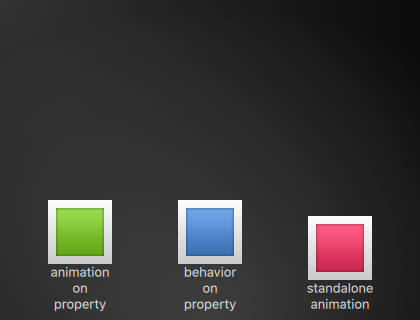
The three objects are all at the same y-position (y=200). They need to travel all to y=40. Each of them using a different method with different side-effects and features.
ClickableImageV2 {
id: greenBox
x: 40; y: root.height-height
source: "assets/box_green.png"
text: "animation on property"
NumberAnimation on y {
to: 40; duration: 4000
}
}
First object
The first object travels using the Animation on <property> strategy. The animation starts immediately. When an object is clicked their y-position is reset to the start position, this applies to all objects. On the first object, the reset does not have any effect as long as the animation is running. It’s even disturbing as the y-position is set for a fraction of a second to a new value before the animation starts. Such competing property changes should be avoided.
ClickableImageV2 {
id: blueBox
x: (root.width-width)/2; y: root.height-height
source: "assets/box_blue.png"
text: "behavior on property"
Behavior on y {
NumberAnimation { duration: 4000 }
}
onClicked: y = 40
// random y on each click
// onClicked: y = 40+Math.random()*(205-40)
}
Second object
The second object travels using a behavior on animation. This behavior tells the property, every time the property value changes, it changes through this animation. The behavior can be disabled by enabled : false on the Behavior element. The object will start traveling when you click it (y-position is then set to 40). Another click has no influence as the position is already set. You could try to use a random value (e.g. 40+(Math.random()*(205-40)) for the y-position. You will see that the object will always animate to the new position and adapt its speed to match the 4 seconds to the destination defined by the duration of the animation.
ClickableImageV2 {
id: redBox
x: root.width-width-40; y: root.height-height
source: "assets/box_red.png"
onClicked: anim.start()
// onClicked: anim.restart()
text: "standalone animation"
NumberAnimation {
id: anim
target: redBox
properties: "y"
to: 40
duration: 4000
}
}
Third object
The third object uses a standalone animation. The animation is defined as its own element and could be everywhere in the document. The click will start the animation using the animations function start(). Each animation has a start(), stop(), resume(), restart() function. The animation itself contains much more information than the other animation types earlier. We need to define the target and properties to declare the target element to be animated and which properties we want to animate. We need to define a to value and in this case, we define also a from value to allow a restart of the animation.
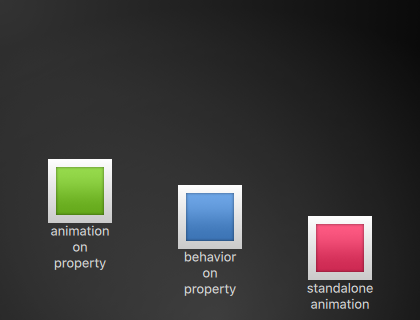
A click on the background will reset all objects to their initial position. The first object cannot be restarted except by re-starting the program which triggers the re-loading of the element.
Note
Another way to start/stop an animation is to bind a property to the running property of an animation. This is especially useful when the user-input is in control of properties:
NumberAnimation {
...
// animation runs when mouse is pressed
running: area.pressed
}
MouseArea {
id: area
}
5.1.3. Easing Curves¶
The value change of a property can be controlled by an animation. Easing attributes allows influencing the interpolation curve of a property change. All animations we have defined by now use a linear interpolation because the initial easing type of an animation is Easing.Linear. It’s best visualized with a small plot, where the y-axis is the property to be animated and the x-axis is the time (duration). A linear interpolation would draw a straight line from the from value at the start of the animation to the to value at the end of the animation. So the easing type defines the curve of change. Easing types are carefully chosen to support a natural fit for a moving object, for example when a page slides out. Initially, the page should slide out slowly and then gain the speed to finally slide out at high speed, similar to turning the page of a book.
Note
Animations should not be overused. As other aspects of UI design also animations should be designed carefully and support the UI flow and not dominate it. The eye is very sensitive to moving objects and animations can easily distract the user.
In the next example, we will try some easing curves. Each easing curve is displayed by a click-able image and, when clicked, will set a new easing type on the square animation and then trigger a restart() to run the animation with the new curve.
The code for this example was made a little bit more complicated. We first create a grid of EasingTypes and a Box which is controlled by the easing types. An easing type just displays the curve which the box shall use for its animation. When the user clicks on an easing curve the box moves in a direction according to the easing curve. The animation itself is a standalone-animation with the target set to the box and configured for x-property animation with a duration of 2 secs.
Note
The internals of the EasingType renders the curve in real time and the interested reader can look it up in the EasingCurves example.
// EasingCurves.qml
import QtQuick 2.5
import QtQuick.Layouts 1.2
Rectangle {
id: root
width: childrenRect.width
height: childrenRect.height
color: '#4a4a4a'
gradient: Gradient {
GradientStop { position: 0.0; color: root.color }
GradientStop { position: 1.0; color: Qt.lighter(root.color, 1.2) }
}
ColumnLayout {
Grid {
spacing: 8
columns: 5
EasingType {
easingType: Easing.Linear
title: 'Linear'
onClicked: {
animation.easing.type = easingType
box.toggle = !box.toggle
}
}
EasingType {
easingType: Easing.InExpo
title: "InExpo"
onClicked: {
animation.easing.type = easingType
box.toggle = !box.toggle
}
}
EasingType {
easingType: Easing.OutExpo
title: "OutExpo"
onClicked: {
animation.easing.type = easingType
box.toggle = !box.toggle
}
}
EasingType {
easingType: Easing.InOutExpo
title: "InOutExpo"
onClicked: {
animation.easing.type = easingType
box.toggle = !box.toggle
}
}
EasingType {
easingType: Easing.InOutCubic
title: "InOutCubic"
onClicked: {
animation.easing.type = easingType
box.toggle = !box.toggle
}
}
EasingType {
easingType: Easing.SineCurve
title: "SineCurve"
onClicked: {
animation.easing.type = easingType
box.toggle = !box.toggle
}
}
EasingType {
easingType: Easing.InOutCirc
title: "InOutCirc"
onClicked: {
animation.easing.type = easingType
box.toggle = !box.toggle
}
}
EasingType {
easingType: Easing.InOutElastic
title: "InOutElastic"
onClicked: {
animation.easing.type = easingType
box.toggle = !box.toggle
}
}
EasingType {
easingType: Easing.InOutBack
title: "InOutBack"
onClicked: {
animation.easing.type = easingType
box.toggle = !box.toggle
}
}
EasingType {
easingType: Easing.InOutBounce
title: "InOutBounce"
onClicked: {
animation.easing.type = easingType
box.toggle = !box.toggle
}
}
}
Item {
height: 80
Layout.fillWidth: true
Box {
id: box
property bool toggle
x: toggle?20:root.width-width-20
anchors.verticalCenter: parent.verticalCenter
gradient: Gradient {
GradientStop { position: 0.0; color: "#2ed5fa" }
GradientStop { position: 1.0; color: "#2467ec" }
}
Behavior on x {
NumberAnimation {
id: animation
duration: 500
}
}
}
}
}
}
Please play with it, please observe the change of speed during an animation. Some animations feel more natural for the object and some feel irritating.
Besides the duration and easing.type you are able to fine tune animations. For example, the general PropertyAnimation where most animation inherits from additionally supports an easing.amplitude, easing.overshoot and easing.period property which allows you to fine-tune the behavior of particular easing curves. Not all easing curves support these parameters. Please consult the easing table from the PropertyAnimation documentation to check if an easing parameter has an influence on an easing curve.
Note
Choosing the right animation for the element in the user interface context is crucial for the outcome. Remember the animation shall support the UI flow; not irritate the user.
5.1.4. Grouped Animations¶
Often animations will be more complex than just animating one property. You might want to run several animations at the same time or one after another or even execute a script between two animations. For this, the grouped animation offer you a possibility. As the named suggests it’s possible to group animations. Grouping can be done in two ways: parallel or sequential. You can use the SequentialAnimation or the ParallelAnimation element, which act as animation containers for other animation elements. These grouped animations are animations themselves and can be used exactly as such.

All direct child animations of a parallel animation will run in parallel when started. This allows you to animate different properties at the same time.
// parallelanimation.qml
import QtQuick 2.5
BrightSquare {
id: root
width: 600
height: 400
property int duration: 3000
property Item ufo: ufo
Image {
anchors.fill: parent
source: "assets/ufo_background.png"
}
ClickableImageV3 {
id: ufo
x: 20; y: root.height-height
text: 'ufo'
source: "assets/ufo.png"
onClicked: anim.restart()
}
ParallelAnimation {
id: anim
NumberAnimation {
target: ufo
properties: "y"
to: 20
duration: root.duration
}
NumberAnimation {
target: ufo
properties: "x"
to: 160
duration: root.duration
}
}
}

A sequential animation will first run the first child animation and then continue from there.
// SequentialAnimationExample.qml
import QtQuick 2.5
BrightSquare {
id: root
width: 600
height: 400
property int duration: 3000
property Item ufo: ufo
Image {
anchors.fill: parent
source: "assets/ufo_background.png"
}
ClickableImageV3 {
id: ufo
x: 20; y: root.height-height
text: 'rocket'
source: "assets/ufo.png"
onClicked: anim.restart()
}
SequentialAnimation {
id: anim
NumberAnimation {
target: ufo
properties: "y"
to: 20
// 60% of time to travel up
duration: root.duration*0.6
}
NumberAnimation {
target: ufo
properties: "x"
to: 400
// 40% of time to travel sideways
duration: root.duration*0.4
}
}
}

Grouped animation can also be nested, for example, a sequential animation can have two parallel animations as child animations, and so on. We can visualize this with a soccer ball example. The idea is to throw a ball from left to right an animate its behavior.
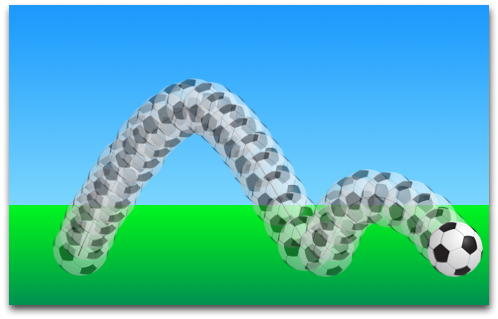
To understand the animation we need to dissect it into the integral transformations of the object. We need to remember animation do animate property changes. Here are the different transformations:
- An x-translation from left-to-right (
X1) - An y-translation from down to up (
Y1) followed by a translation from up to down (Y2) with some bouncing - A rotation over 360 over the whole animation duration (
ROT1)
The whole duration of the animation should take three seconds.
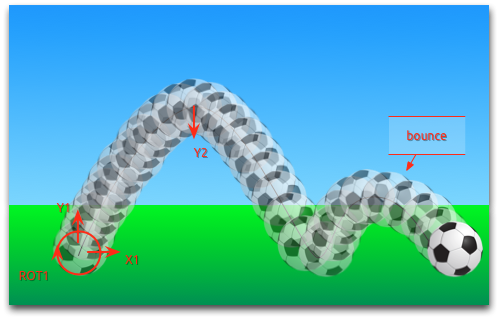
We start with an empty item as the root element of the width of 480 and height of 300.
import QtQuick 2.5
Item {
id: root
width: 480
height: 300
property int duration: 3000
...
}
We have defined our total animation duration as a reference to better synchronize the animation parts.
The next step would be to add the background, which in our case are 2 rectangles with a green and blue gradients.
Rectangle {
id: sky
width: parent.width
height: 200
gradient: Gradient {
GradientStop { position: 0.0; color: "#0080FF" }
GradientStop { position: 1.0; color: "#66CCFF" }
}
}
Rectangle {
id: ground
anchors.top: sky.bottom
anchors.bottom: root.bottom
width: parent.width
gradient: Gradient {
GradientStop { position: 0.0; color: "#00FF00" }
GradientStop { position: 1.0; color: "#00803F" }
}
}

The upper blue rectangle takes 200 pixels of the height and the lower one is anchored to the top of the sky and to the bottom on the root element.
Let’s bring the soccer ball onto the green. The ball is an image, stored under “assets/soccer_ball.png”. For the beginning, we would like to position it in the lower left corner, near the edge.
Image {
id: ball
x: 0; y: root.height-height
source: "assets/soccer_ball.png"
MouseArea {
anchors.fill: parent
onClicked: {
ball.x = 0;
ball.y = root.height-ball.height;
ball.rotation = 0;
anim.restart()
}
}
}
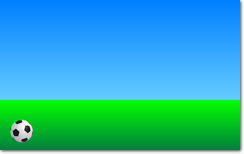
The image has a mouse area attached to it. If the ball is clicked the position of the ball will reset and the animation restarted.
Let’s start with a sequential animation for the two y translations first.
SequentialAnimation {
id: anim
NumberAnimation {
target: ball
properties: "y"
to: 20
duration: root.duration * 0.4
}
NumberAnimation {
target: ball
properties: "y"
to: 240
duration: root.duration * 0.6
}
}

This specifies that 40% of the total animation duration is the up animation and 60% the down animation. One animation after another as a sequence. The transformations are animated on a linear path but there is no curving currently. Curves will be added later using the easing curves, at the moment we’re concentrating on getting the transformations animated.
Next, we need to add the x-translation. The x-translation shall run in parallel with the y-translation so we need to encapsulate the sequence of y-translations into a parallel animation together with the x-translation.
ParallelAnimation {
id: anim
SequentialAnimation {
// ... our Y1, Y2 animation
}
NumberAnimation { // X1 animation
target: ball
properties: "x"
to: 400
duration: root.duration
}
}

In the end, we would like the ball to be rotating. For this, we need to add another animation to the parallel animation. We choose the RotationAnimation as it’s specialized for rotation.
ParallelAnimation {
id: anim
SequentialAnimation {
// ... our Y1, Y2 animation
}
NumberAnimation { // X1 animation
// X1 animation
}
RotationAnimation {
target: ball
properties: "rotation"
to: 720
duration: root.duration
}
}
That’s the whole animation sequence. The one thing left is to provide the correct easing curves for the movements of the ball. For the Y1 animation I use a Easing.OutCirc curve as this should look more like a circular movement. Y2 is enhanced using an Easing.OutBounce as the ball should bounce and the bouncing should happen at the end (try an Easing.InBounce and you see the bouncing will start right away).
The X1 and ROT1 animation are left as is with a linear curve.
Here is the final animation code for your reference:
ParallelAnimation {
id: anim
SequentialAnimation {
NumberAnimation {
target: ball
properties: "y"
to: 20
duration: root.duration * 0.4
easing.type: Easing.OutCirc
}
NumberAnimation {
target: ball
properties: "y"
to: root.height-ball.height
duration: root.duration * 0.6
easing.type: Easing.OutBounce
}
}
NumberAnimation {
target: ball
properties: "x"
to: root.width-ball.width
duration: root.duration
}
RotationAnimation {
target: ball
properties: "rotation"
to: 720
duration: root.duration
}
}
5.2. States and Transitions¶
Often parts of a user interface can be described in states. A state defines a set of property changes and can be triggered by a certain condition. Additional these state switches can have a transition attached which defines how these changes should be animated or any additional actions shall be applied. Actions can also be applied when a state is entered.
5.2.1. States¶
You define states in QML with the State element, which needs to be bound to the states array of any item element. A state is identified through a state name and consist, in its simplest form, of a series of property changes on elements. The default state is defined by the initial properties of the element and is named "" (the empty string).
Item {
id: root
states: [
State {
name: "go"
PropertyChanges { ... }
},
State {
name: "stop"
PropertyChanges { ... }
}
]
}
A state is changed by assigning a new state name to the state property of the element with the states defined.
Note
Another way to switch states is using the when property of the State element. The when property can be set to an expression that evaluates to true when the state should be applied.
Item {
id: root
states: [
...
]
Button {
id: goButton
...
onClicked: root.state = "go"
}
}
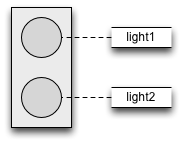
For example, a traffic light might have two signaling lights. The upper one signaling stop with a red color and the lower one signaling go with a green color. In this example, both lights should not shine at the same time. Let’s have a look at the state chart diagram.

When the system is switched on it goes automatically into the stop mode as the default state. The stop state changes the light1 to red and light2 to black (off). An external event can now trigger a state switch to the "go" state. In the go state, we change the color properties from light1 to black (off) and light2 to green to indicate the passers may walk now.
To realize this scenario we start sketching our user interface for the 2 lights. For simplicity, we use 2 rectangles with the radius set to the half of the width (and the width is the same as the height, which means it’s a square).
Rectangle {
id: light1
x: 25; y: 15
width: 100; height: width
radius: width/2
color: root.black
border.color: Qt.lighter(color, 1.1)
}
Rectangle {
id: light2
x: 25; y: 135
width: 100; height: width
radius: width/2
color: root.black
border.color: Qt.lighter(color, 1.1)
}
As defined in the state chart we want to have two states one the "go" state and the other the "stop" state, where each of them changes the traffic lights respective to red or green. We set the state property to stop to ensure the initial state of our traffic light is the stop state.
Note
We could have achieved the same effect with only a "go" state and no explicit "stop" state by setting the color of light1 to red and the color of light2 to black. The initial state "" defined by the initial property values would then act as the "stop" state.
state: "stop"
states: [
State {
name: "stop"
PropertyChanges { target: light1; color: root.red }
PropertyChanges { target: light2; color: root.black }
},
State {
name: "go"
PropertyChanges { target: light1; color: root.black }
PropertyChanges { target: light2; color: root.green }
}
]
Using PropertyChanges { target: light2; color: "black" } is not really required in this examples as the initial color of light2 is already black. In a state, it’s only necessary to describe how the properties shall change from their default state (and not from the previous state).
A state change is triggered using a mouse area which covers the whole traffic light and toggles between the go- and stop-state when clicked.
MouseArea {
anchors.fill: parent
onClicked: parent.state = (parent.state == "stop"? "go" : "stop")
}

We are now able to successfully change the state of the traffic lamp. To make the UI more appealing and look natural we should add some transitions with animation effects. A transition can be triggered by a state change.
Note
It’s possible to create a similar logic using scripting instead of QML states. Developers can easily fall into the trap of writing more a JavaScript program than a QML program.
5.2.2. Transitions¶
A series of transitions can be added to every item. A transition is executed by a state change. You can define on which state change a particular transition can be applied using the from: and to: properties. These two properties act like a filter when the filter is true the transition will be applied. You can also use the wild-cast “*” which means “any state”. For example from:"*"; to:"*" means from any state to any other state and is the default value for from and to, which means the transition is applied to every state switch.
For this example, we would like to animate the color changes when switching state from “go” to “stop”. For the other reversed state change (“stop” to “go”) we want to keep an immediate color change and don’t apply a transition. We restrict the transition with the from and to properties to filter only the state change from “go” to “stop”. Inside the transition, we add two color animations for each light, which shall animate the property changes defined in the state description.
transitions: [
Transition {
from: "stop"; to: "go"
// from: "*"; to: "*"
ColorAnimation { target: light1; properties: "color"; duration: 2000 }
ColorAnimation { target: light2; properties: "color"; duration: 2000 }
}
]
You can change the state though clicking the UI. The state is applied immediately and will also change the state while a transition is running. So try to click the UI while the state is in the transition from “stop” to “go”. You will see the change will happen immediately.
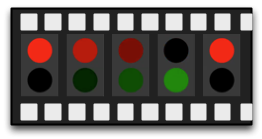
You could play around with this UI by, for example, scaling the inactive light down to highlight the active light. For this, you would need to add another property change for scaling to the states and also handle the animation for the scaling property in the transition. Another option would be to add an “attention” state where the lights are blinking yellow. For this, you would need to add a sequential animation to the transition for one second going to yellow (“to” property of the animation and one sec going to “black”). Maybe you would also want to change the easing curve to make it more visually appealing.
